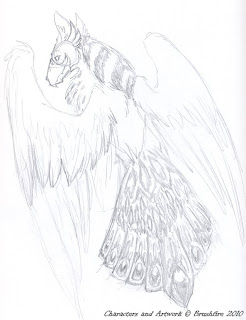So for those of you who followed me on Live journal this will be my new hangout. I won't be reposting old entries, but all my sketches from here on out will be on here (Unless I spontaneously change my mind again ;p)
The pictures all look small, to view them full size just click on them :)

Here we have some moss and crystals I was practicing.

This is a moss unicorn. They roam the forests that my mushroom bugs live in. They are rarely ever seen as they have the ability to lay down and completely disapear into the undergrowth, next time you see a lump that looks like a rock grown over in moss, small plants and mushrooms you may be looking at a moss unicorn, you also may be looking at a rock.
They are essentially forest spirits, and plants sprout from their tracks. Buttermoose live on moss unicorns in a symbiotic relationship; one way to tell if a moss unicorn is around is if you see any buttermoose, they rarely stray far from their host. A moss unicorn usually supports about 15-20 buttermoose.
The buttermoose feed of spores, dead plant matter and nectar produced by the vegetation on the moss unicorn's helping to keep them groomed. This food is the source of the buttermoose's magic.

I was practicing drawing tigers here.

The beetle you see is my redesigned beast of burden for my mushroom bugs, they are known as beetles of burden, or beedens for short.

Along the top of this next image you see what a mushroom bug does when afraid, they often find mushroom patches which they can camouflage into. It is very rare for a human to see a muchroom bug because of this tactic, but be careful if you are ever out picking mushrooms! Pull up a mushroom bug and you will probably receive a nasty poison bite. While their poison is not deadly it is considered more painful then a bee sting. Once they bite they usually take off, and can move surprisingly quick.
The second picture down is a mushroom bug meeting another species of mushroom bug, these mushroom bugs are found in more mountainous regions, and possess a strong back pair of jumping legs for getting around on steep slopes, they occasionally come down from the mountains to trade mushrooms (A mushroom bug's primary food source) with our well known forest mushroom bugs. Little is known about their culture at this point.
The last two pictures on the bottom of this page is my final design for my buttermoose. The insides of their wings(sides closest to their body) changes colour depending in their mood and the outside of their wings(dorsal side) is iridescent. When a buttermoose is feeling excited or playful the inside of their wings shimmers a rainbow of colours.

A cute little picture I did of a pair of mushroom bugs watching the sunset. Mushroom bugs are dioecious (having males and females) and mate for life. They are also nocturnal so sunsets are their mornings. :)

A picture I did of haze (my Pegasus/donkey character) I doodled up because I haven't drawn him in so long.

Some doodles including my unicorn girl character Lima.

More sketches of tigers.

Some more random doodles.

Another picture of Haze, he so cute :)

A buttermoose catching some shut-eye under a fern in the rain

A random picture I came up with of a rider passing through a forest of giant moss, I may expand on this idea in the future, moss is so cool!

Alright so for my final picture of the day I am gonna go back into my mushroom world. You can see I have drawn a mushroom bug riding his beetle of burden, a cute little watch owl and that big terrifying wolf looking thing. That is a jackal.
Jackals are a mushroom bugs worst nightmare, they are a noctural predator which loves the taste of mushroom bugs. They usually prey on lone mushroom bugs out gathering mushrooms.
Jackals have very sensitive eyes and are blinded by lights. This is why mushroom bugs are often seen carrying lanterns and why they light up their towns with bonfires, glowing mushrooms and lanterns.
Although significantly smaller then jackals mushroom bugs have domesticated noles (http://img.photobucket.com/albums/v481/Brushfire/blog/anole.jpg) to help protect them from jackals since a nole can be very aggressive and have been known form packs to attack jackals in the wild.
This is also why mushroom bugs domesticated watch owls. Watch owls are terrified of jackals and have developed keen night vision based on infrared wavelengths (they see heat). In the wild a watch owl feed on seeds on the ground(where they occassionally fall prey to jackals), but will fly to the highest perch when they spot a jackal and hoot loudly and continuously to alert other owls in the area. Because of this trait they makes the perfect sentries for mushroom bug communities.
Anyway this is it for now
Until next time!
- Brushfire




























